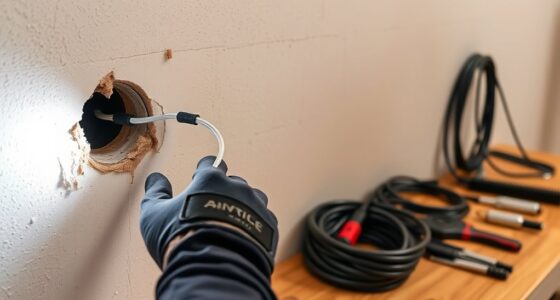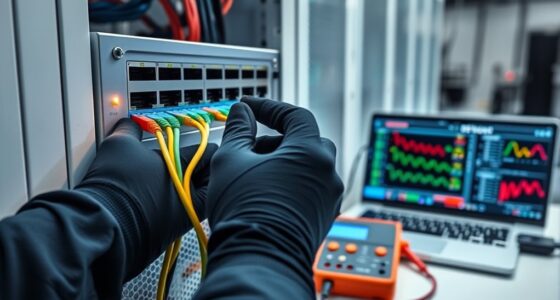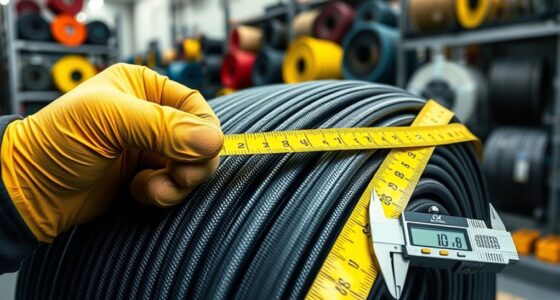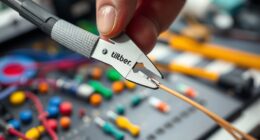When pulling cables, you should apply lubricant when resistance increases, or signs of friction appear, especially at bends or tight spots. Before you start, clean and inspect the conduit and cable, then evenly coat the cable with a suitable lubricant—water-based, silicone, or petroleum—depending on the environment. Reapply as needed when resistance rises or after passing through difficult sections. Stay aware of proper techniques and safety precautions to guarantee smooth installation; more details await if you continue.
Key Takeaways
- Use lubricants when resistance, squeaking, or signs of wear appear during cable pulling.
- Prepare conduits by cleaning and inspecting before applying a thin, even lubricant coating.
- Select lubricant types based on environment, cable material, and conduit conditions for optimal performance.
- Reapply lubricant during pulling if resistance increases or after passing through rough or tight sections.
- Post-installation, inspect for damage, check lubricant effectiveness, and reapply as needed for future durability.
Signs That Signal the Need for Lubricant Application

Recognizing the signs that indicate your cable needs lubricant is essential for smooth and safe pulling operations. If you notice increased resistance or audible squeaking during cable pull, it’s a clear sign to apply lubricant. Don’t fall for cable lubricant myths that suggest you can skip lubrication altogether; proper lubrication reduces friction and prevents damage. Additionally, if you see signs of overheating or excessive cable wear, it’s time to add lubricant. Always follow lubricant disposal tips to prevent environmental harm—never pour lubricant down drains or onto the ground. Using the right lubricant at the right time guarantees a smoother pull, minimizes cable stress, and extends cable life. Proper maintenance also involves understanding air quality factors that can affect the equipment and environment during installation. Staying attentive to these signs helps you maintain efficiency and safety throughout the installation process. Incorporating automation in business intelligence can also assist in monitoring operational parameters and predicting maintenance needs proactively. Being aware of headphone compatibility and ensuring your tools are suitable can also enhance overall safety and effectiveness during cable pulling.
Key Moments During the Cable Installation Process

Understanding the key moments in cable installation helps guarantee a smooth process. You’ll want to focus on pre-lubrication preparation, the actual pulling, and post-installation checks. Paying attention to these steps keeps the cable protected and minimizes issues later on. Additionally, considering the projector technology involved can help determine the appropriate type of lubricant to use for optimal results. A methodical approach, including proper testing and inspection, can further ensure the durability and performance of the installed cable, aligning with best quality assurance practices. Monitoring the expiration of lubricants and replacing them as needed can also prevent potential issues during installation.
Pre-lubrication Preparation
Before you begin pulling the cable, make sure the conduit is clean and free of debris, as any obstructions can increase friction and cause damage. Inspect the conduit material to verify it’s appropriate for the cable type and resistant to corrosion or wear. Check the cable insulation for any cracks, tears, or defects that could compromise its integrity during installation. Proper pre-lubrication preparation involves choosing the right lubricant compatible with both the cable insulation and the conduit material. Apply a thin, even coating of lubricant to the cable, focusing on areas with tight bends or friction points. This reduces resistance and facilitates smoother pulling. Additionally, understanding the material options of cable lubricants can help select the most effective product for your specific installation. Selecting the appropriate lubricant type based on cable and conduit materials is crucial for preventing damage and ensuring ease of installation. Taking these steps beforehand minimizes the risk of damage, streamlines installation, and helps ensure the longevity of your cable system. Proper pre-lubrication not only improves efficiency but also can significantly extend the life of both the cable and conduit. Being aware of cookie categories related to website management can also aid in understanding how online resources are optimized for user experience.
During Cable Pulling
As you begin pulling the cable, keep a close eye on the process to catch any signs of increased resistance or snagging. Maintaining proper cable tension is vital; too much tension risks damage, while too little can cause slack. Adjust lubricant viscosity if you notice increased resistance—thinner lubricants reduce friction, easing the pull. Regularly monitor the cable’s progress and reapply lubricant as needed to keep it flowing smoothly. Proper lubrication during pulling minimizes heat buildup and protects the cable’s outer sheath. Use the following guide: Active listening and empathy are essential for understanding the unique challenges during cable installation to ensure smooth progress. Recognizing proper cable tension helps prevent damage and ensures efficiency during the process, especially considering the importance of cable quality in overall performance. Additionally, selecting the right lubricant viscosity can significantly impact the ease of cable pulling and reduce wear on the cable and equipment.
Post-installation Checks
Once the cable has been fully installed, it’s important to perform thorough post-installation checks to guarantee everything is in proper order. First, inspect the conduit for any damage or obstructions that could hinder future access or maintenance. Next, verify that the cable is properly stored and secured, preventing unnecessary movement or strain. Additionally, ensure the cable’s routing aligns with the original plan, confirming no kinks or twists have occurred during pulling. Check for signs of wear, especially at bends and entry points, and document the installation for future reference. Moreover, inspecting paint sprayer accessories like nozzles and strainers ensures optimal performance and prevents future issues. Ensuring compatibility with tuning modifications in related systems can also prevent potential failures. Proper cable lubrication can reduce friction during pulling and minimize damage, making it a crucial step in the process. Using cable pulling lubricants at appropriate stages can significantly decrease the risk of cable damage and ease the installation process. These steps help prevent issues down the line, ensuring cable longevity and reliable performance. Proper post-installation checks are essential for maintaining the integrity of your cable system.
Types of Cable Pulling Lubricants and Their Best Uses

Understanding the different types of cable pulling lubricants helps you choose the right one for your project. Each lubricant has specific applications, so knowing where they work best is essential. Safety and compatibility also play key roles in making an effective, reliable selection. Utilizing industry trends can further inform your choice of lubricant to ensure optimal performance. Considering textile line innovations can introduce new formulations that improve lubrication efficiency and safety. Additionally, staying informed about raw food preservation techniques can inspire the development of eco-friendly and sustainable lubricant options. Awareness of French Press Operation and other brewing techniques highlights the importance of proper preparation and application methods to maximize effectiveness and safety in various settings.
Lubricant Types Overview
Have you ever wondered which cable pulling lubricant is best suited for your project? Choosing the right type depends on factors like cable material, environment, and ease of application. Here are three common lubricant types:
- Water-based lubricants: These are eco-friendly, easy to clean, and safe for cable storage. They’re ideal for short runs and dry environments but may require frequent reapplication.
- Silicone-based lubricants: Known for their excellent lubricity and water resistance, they’re great for long pulls and wet conditions. Proper disposal is essential to avoid environmental impact.
- Petroleum-based lubricants: These provide superior slip but can be messy and challenging to dispose of. Use them with caution, especially near sensitive equipment or when considering lubricant disposal procedures.
Always consider these factors to guarantee peak performance and safety.
Suitable Application Scenarios
Choosing the right lubricant depends heavily on the specific conditions of your cable pulling project. For cable lubrication, consider the environment—wet, dry, or confined spaces—since different lubricants excel in different scenarios. For example, water-based lubricants work well in moist conditions and are easy to clean, while wax-based options provide long-lasting lubrication in dry areas. The application timing also matters; apply lubricants before pulling begins to reduce friction and prevent damage, but avoid over-lubrication that can cause mess or safety issues. If you’re pulling through tight bends or rough surfaces, select lubricants designed for high friction areas. Matching the right type of cable lubrication to your application scenario guarantees smoother pulls, reduces cable damage, and improves efficiency.
Compatibility and Safety
Selecting the right cable pulling lubricant requires careful attention to compatibility and safety considerations. You must guarantee the lubricant’s material compatibility to prevent damage to cables or conduit. Chemical safety is equally important to protect users and the environment. To choose wisely:
- Check the lubricant’s compatibility with cable insulation and conduit materials to avoid degradation.
- Review safety data sheets to confirm non-toxicity and proper handling procedures.
- Select lubricants that comply with industry standards for chemical safety, reducing risks of adverse reactions or health hazards.
Preparing Your Cables and Conduits for Lubricant Application

Before applying lubricant, it’s essential to prepare your cables and conduits properly to guarantee smooth operation. Start by inspecting the cable material to make sure there are no damages or debris that could hinder movement. Clean the conduit to remove dirt, dust, or obstructions that might cause resistance during pulling. Check the conduit size to confirm it matches the cable’s diameter; a conduit that’s too tight can damage the cable, while one that’s too large may reduce control. Use a suitable brush or vacuum to clear out debris from the conduit if needed. Additionally, lubricate the inside of the conduit lightly if necessary, especially for longer runs. Proper preparation minimizes friction, reduces the risk of cable damage, and guarantees a smoother pulling process.
Proper Techniques for Applying Cable Pulling Lubricants

Applying cable pulling lubricants correctly is crucial for guaranteeing a smooth and efficient installation. First, apply the lubricant evenly along the cable’s length, focusing on areas with cable marking or bends. Use a brush or applicator to prevent excess buildup. Second, ensure proper lubricant storage; keep containers sealed and stored in a cool, dry place to maintain quality and prevent contamination. Third, reapply lubricant at key points, such as junctions or when changing conduit sections, to minimize friction. Always check that the lubricant’s viscosity matches the cable type and installation environment. Proper application techniques reduce cable damage and facilitate easier pulling, saving time and effort. Remember, a well-lubricated cable is essential for a successful, damage-free installation.
Safety Precautions When Using Lubricants

Using cable pulling lubricants safely is essential to protect yourself and prevent accidents. Always read the manufacturer’s instructions carefully, paying attention to the chemical composition. Some lubricants contain chemicals that can cause skin irritation or respiratory issues if mishandled. Wear appropriate personal protective equipment, such as gloves and masks, to minimize exposure. Be aware of the environmental impact, and avoid releasing lubricants into water sources or soil. Use only the recommended amount to prevent unnecessary spills or waste. Ensure proper ventilation in enclosed spaces to disperse fumes. Proper storage is crucial; keep lubricants away from heat and ignition sources. By following these precautions, you help ensure your safety and reduce environmental risks.
Common Mistakes to Avoid When Using Lubricants

One common mistake is overusing lubricant, which can lead to messy spills, environmental harm, and increased costs. Excess lubricant overspread on the cable or conduit can cause debris accumulation and make inspections difficult. To avoid this, keep these points in mind:
Overapplying lubricant causes mess, environmental harm, and inspection issues; use only what’s necessary and distribute evenly.
- Apply only the necessary amount; excessive lubricant isn’t more effective and creates cleanup issues.
- Distribute lubricant evenly, preventing overspread that can cause a mess and reduce efficiency.
- Refrain from reapplying without evaluating if it’s needed, as unnecessary lubrication contributes to common mistakes and waste.
Being mindful of lubricant application helps maintain a cleaner work environment and ensures ideal performance, avoiding the pitfalls of common mistakes like lubricant overspread.
Environmental Factors That Influence Lubricant Effectiveness

Environmental conditions play a vital role in how well cable pulling lubricants perform. Environmental challenges like extreme temperatures, moisture, dirt, and UV exposure can significantly impact lubricant effectiveness. High heat can cause lubricant degradation, reducing its ability to reduce friction and protect the cable. Cold temperatures may thicken the lubricant, making it less effective and harder to apply smoothly. Moisture and dirt can contaminate the lubricant, diminishing its protective qualities and increasing the risk of cable damage. UV exposure can break down certain lubricants over time, leading to premature wear. To ensure optimal performance, you must select lubricants suited for specific environmental conditions and consider reapplication if environmental challenges threaten to compromise the lubricant’s protective properties.
Maintenance and Reapplication During Long or Complex Pulls

During long or complex cable pulls, maintaining the effectiveness of lubricants becomes increasingly important. Regular lubricant reapplication ensures smooth cable movement and reduces wear. To manage this effectively, consider these steps:
Regular lubricant reapplication ensures smooth cable movement during long or complex pulls.
- Monitor the cable for signs of increased friction or resistance, indicating the need for lubricant reapplication.
- Reapply cable lubrication at designated intervals or after passing through challenging sections to maintain ideal lubrication levels.
- Use appropriate lubricants suited for the environment and cable type, ensuring compatibility and effectiveness throughout the pull.
Frequently Asked Questions
How Do I Choose the Right Lubricant for My Specific Cable Type?
To select the appropriate lubricant, first consider your cable material compatibility—some lubricants may harm certain plastics or coatings. Then, evaluate lubricant viscosity selection; a thinner lubricant is ideal for long runs or tight bends, while a thicker one offers better lubrication for heavier loads. Always check manufacturer recommendations to guarantee compatibility and peak performance, preventing damage and easing the pulling process.
Can Using Too Much Lubricant Cause Cable Damage?
Using too much lubricant can damage your cable, as over-lubrication might lead to excess buildup that affects cable insulation and hampers movement. Studies show that improper lubrication accounts for nearly 30% of cable failures. Always make certain lubricant compatibility with your cable’s insulation type and apply only the recommended amount. Too much lubricant reduces friction but can cause insulation deterioration, increasing the risk of damage during pulling.
Are There Environmentally Friendly Lubricant Options Available?
Yes, eco-friendly formulas and biodegradable options are available for cable pulling lubricants. These environmentally friendly options help you reduce your ecological impact while ensuring smooth cable installation. Look for lubricants labeled as biodegradable or made from natural ingredients, which break down safely in the environment. Using these lubricants supports sustainable practices without sacrificing performance, making them a smart choice for responsible projects.
How Long Does a Lubricant’s Effectiveness Typically Last During Installation?
Sure, your lubricant’s effectiveness typically lasts about as long as a soap bubble—usually a few minutes to an hour—before it dries out or loses its slickness. During installation, expect the lubricant to maintain its magic for roughly 30 minutes to an hour before lubricant drying starts to hinder your progress. So, keep an eye on it, reapply if needed, and don’t expect miracles to last forever!
What Are the Signs of Lubricant Contamination or Degradation?
You’ll notice lubricant contamination or degradation if the lubricant appears dirty, cloudy, or sticky, which can cause increased resistance during pulling. You might also hear squealing or experience difficulty moving the cable smoothly. These signs indicate that lubricant contamination or lubricant degradation has occurred, reducing its effectiveness. It’s essential to regularly inspect the lubricant and replace it promptly to prevent damage or delays during installation.
Conclusion
Mastering cable pulling lubricants isn’t just a step—it’s the secret weapon that turns a tough job into a breeze. When you know exactly when and how to use them, you’ll breeze through installations faster than you ever imagined possible. Skip this crucial step, and you risk epic struggles, damage, and delays. So arm yourself with the right lubricant knowledge, and watch your cable pulls become legendary feats of efficiency and ease—your project’s success depends on it!








